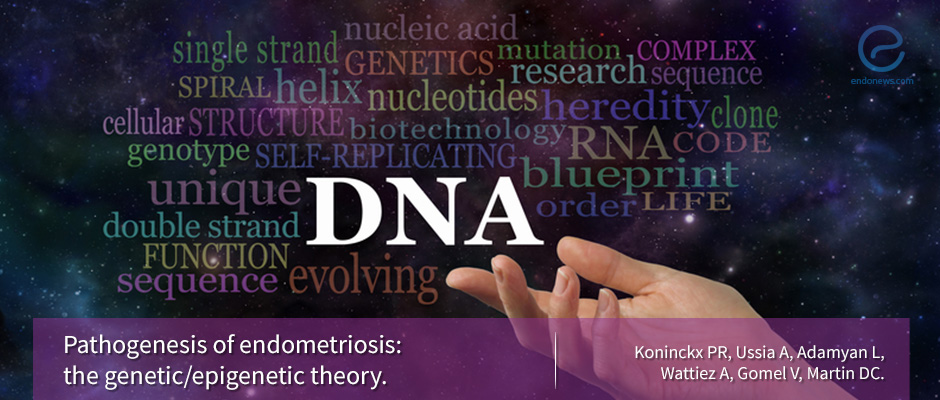A new theory in the pathogenesis of endometriosis
Feb 1, 2019
A comprehensive theory for endometriosis pathogenesis
Key Points
Highlight:
- The genetic/epigenetic theory suggests that the origin of endometriosis can be an endometrial cell, a stem cell, or a bone marrow cell. These may have inherited genetic and epigenetic defects.
- After the implantation or metaplasia, the microscopic lesions occur. They either regress or progress into the typical, cystic or deep penetrating lesions.
- This theory is similar to multistep tumor development and explains the vast variety of clinical features of endometriosis.
Background:
- Endometriosis is known since the beginning of the 20th century. There is no nonhuman model to study this disease. That is why the research is based on clinical features as well as tissues obtained from the patients.
- Endometriosis has a variable clinical appearance. There are many development theories. There are known hereditary and predisposition factors. The disease has a variable course in a patient, which may include pain, infections, and infertility. There is also a known cancer risk.
- Although there is a proposed retrograde menstruation theory, the endometriotic tissue has different physiology compared to the normal endometrium.
- The genetic studies have given variable results. And the genetics of endometriosis is not yet clear.
What's Done Here
- Authors have reviewed the literature to describe the pathogenesis of endometriosis and proposed a theory.
Key Results:
- In terms of clinical features;
- Clinical symptoms vary; endometriosis may be not pigmented, deep endometriosis invades organs.
- Risk of developing endometriosis is 6%–15% higher in relatives of women with endometriosis.
- Genome-wide and linkage analysis have different results and the conclusions are not clear.
- Progression and regression have been observed and recurrence rate varies.
- During pregnancy, endometriosis responds to hormonal changes and may enlarge, and may cause organ perforations.
- In terms of Pathogenesis:
- Retrograde Menstruation Theory has been proposed for a long time. But it does not explain all cases; such as extragonadal occurrence and clonality.
- Mesothelial Cell Metaplasia is also proposed as a pathogenetic mechanism
- In the light of above theories these points should also be considered:
- Genetic incidents are required for the development of typical, cystic, or deep endometriosis.
- Microscopic endometriosis occur in all women and only in some these progress into lesions
- Subtle or microscopic lesions will progress to more severe lesions only if additional incidents happen.
- Typical, cystic, and deep endometriosis are three different diseases
- Thus, a more inclusive theory is proposed: The Genetic/Epigenetic Theory
- The genetic/epigenetic theory suggests that the origin of endometriosis can be an endometrial cell, a stem cell, or a bone marrow cell.
- These may have inherited genetic and epigenetic defects.
- After the implantation or metaplasia, the microscopic lesions occur.
- These microscopic lesions either regress spontaneously or progress into lesions.
- The lesions may be typical, cystic or deep penetrating.
- This theory is similar to multistep tumor development and explains the vast variety of clinical features of endometriosis.
Lay Summary
Koninckx et. al., from various countries, have conducted this review, which will be published in Fertility and Sterility.
Endometriosis is known for a century. The disease has a variable course in a patient, which may include pain, infections, and infertility. There is also a known cancer risk. Although there are so many research on this disease, the exact pathogenesis is not clear. The genetic studies have given variable results. And the genetics of endometriosis is not yet clear.
There are two theories for the pathogenesis:
- According to retrograde menstruation theory, endometrial tissue is transferred to the abdomen via Fallopian tubes during menstruation.
- According to the metaplastic theory, the cells in the abdomen have a similar origin with endometrium, and they change into endometrial tissue.
In this manuscript, the authors propose a more comprehensive theory "The Genetic/Epigenetic Theory", which suggests that the origin of endometriosis can be an endometrial cell, a stem cell, or a bone marrow cell. These cells may have inherited genetic and epigenetic defects, and after the implantation or metaplasia, the microscopic lesions occur. These microscopic lesions either regress spontaneously or progress into endometriosis lesions which may be typical, cystic or deep penetrating.
This theory is similar to multistep tumor development and according to the authors, explains the vast variety of clinical features of endometriosis.
Research Source: https://www.ncbi.nlm.nih.gov/pubmed/30527836
endometriosis clinical features pathogenesis genetic epigenetic

